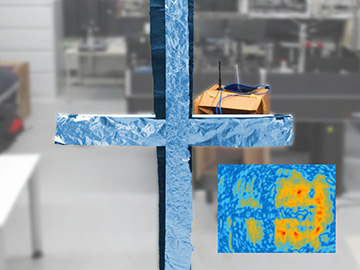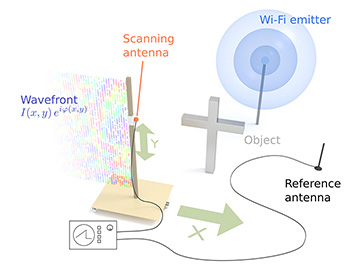The TUM team was able to image a meter-sized cross, by creating holograms from radiation emanating from a standard wireless router. [Image: Technische Universität München] [Enlarge image]
When most of us think of holograms, we think first of Princess Leia, seeking help from Obi-Wan—or, perhaps, of eerie 3-D images created mainly using coherent laser light. Now, scientists at the Technische Universität München (TUM), Germany, have revealed a technique for creating holographic images using what seems a far less likely light source: the scattered microwave radiation from a Wi-Fi router (Phys. Rev. Lett., doi: 10.1103/PhysRevLett.118.183901).
The researchers believe that the technique, with some additional tuning, could have applications in the emerging Industrial Internet of Things (IIoT). It also raises some interesting questions about privacy in a Wi-Fi-saturated world.
A different kind of light source
At its simplest level, a hologram is a representation of a 2-D wavefront that captures information—encoded as an interference pattern—about a 3-D view. Traditionally, the light source is a laser beam, split into an illumination beam and a reference beam to create the speckled hologram. The 3-D representation of the illuminated object is then recovered by shining a reconstruction beam, identical with the reference beam, on the hologram; the surface pattern of the hologram diffracts the beam in a pattern that reproduces the original scattered light field.
In many recent applications, digital and algorithmic reconstruction takes the place of an actual reconstruction beam. And, while lasers constitute the usual source of illumination, they’re not the only possibility. Indeed, holography was first devised to address problems in electron microscopy, before lasers even existed, and holograms have also been created using X-rays, sound waves and even neutron beams. TUM researchers Philipp Holl and Friedemann Reinhard wondered if they could pull off the same feat with Wi-Fi radiation, considered as coherent electromagnetic waves—that is, waves with a well-defined amplitude and phase.
Virtual screen
The setup used a synthetic-aperture approach, sweeping an antenna across a 3×2-m field to create a virtual screen for the hologram. A second, stationary reference antenna allowed numerical reconstruction of the complete complex field. [Image: Technische Universität München] [Enlarge image]
To grab holograms from a Wi-Fi source, Holl and Reinhard set up a room with a reflective object—specifically, a 1-m-wide cross, covered in aluminum foil—placed a bit less than a meter in front of a standard 5-GHz commercial Wi-Fi router. The team used a synthetic-aperture approach to capture the scattered light field for generating the hologram: they moved a tall scanning antenna across a 3×2-m plane in front of the cross, thereby creating a virtual screen for projecting the 3-D wave field into a 2-D hologram.
A second Wi-Fi antenna was placed at a different location to serve as a stationary reference, allowing Holl and Reinhard to use numerical techniques to recover the full complex field. By doing this pixel-by-pixel at every point along the virtual screen, Holl and Reinhard created a digital “2-D map of both phase and amplitude for each frequency … within the Wi-Fi channel employed”—that is, a highly speckled hologram.
Reconstructing the cross
To turn that speckled 2-D map into an image of the cross, the TUM duo drew on a number of other numerical techniques. First, they used a backpropagation algorithm to reconstruct the image at various distances or image planes, creating a stack of 2-D images for a crude 3-D representation. The result was a still-speckled image dominated, perhaps not surprisingly, by the bright signal from the router itself.
The researchers then reduced the speckle intensity using recently developed incoherent white-light holography techniques. Finally, they leveraged dark-field propagation—numerically masking the router signal in the image plane, and subtracting the remaining propagated field between the router and the object from the reconstructed image—to clean up and sharpen the contrast of the imaged cross.
Tracking objects in smart factories
Holl and Reinhard envision a number of improvements going forward—in particular, replacing the synthetic-aperture approach with a fixed 2-D antenna array, to allow much faster capture of the signal; and the order-of-magnitude increase expected in coming years for Wi-Fi transmission frequencies, which would decrease speckle and improve resolution to the millimeter level. Such improvements, the scientists suggest, could make 3-D Wi-Fi imaging at video rates feasible.
The team believes that such a setup might find numerous applications, particularly in the IIoT. The system’s ability to locate point sources—using a signal that can penetrate walls—could, the researchers argue, allow it to track RF-labeled objects even on a crowded smart-factory floor. They also suggest potential applications in disaster settings, where a Wi-Fi holographic representation of a collapsed building, for example, could help rescue teams figure out the best route to reach victims. (Making such schemes work in the messy “real world” could prove complicated, however, given the variety of metallic and reflective objects that could mix up the signal.)
The team’s result also raises some interesting questions regarding privacy. As Holl and Reinhard note in the study’s conclusion, even an encrypted Wi-Fi signal could be used to reconstruct an image of a closed room in this way, given the right equipment. But Reinhard notes that doing so would require “going around the building with a large antenna”—hardly the most subtle method for would-be snoops. “It is rather unlikely,” he says, “that this process will be used for a view into foreign bedrooms in the near future.”


